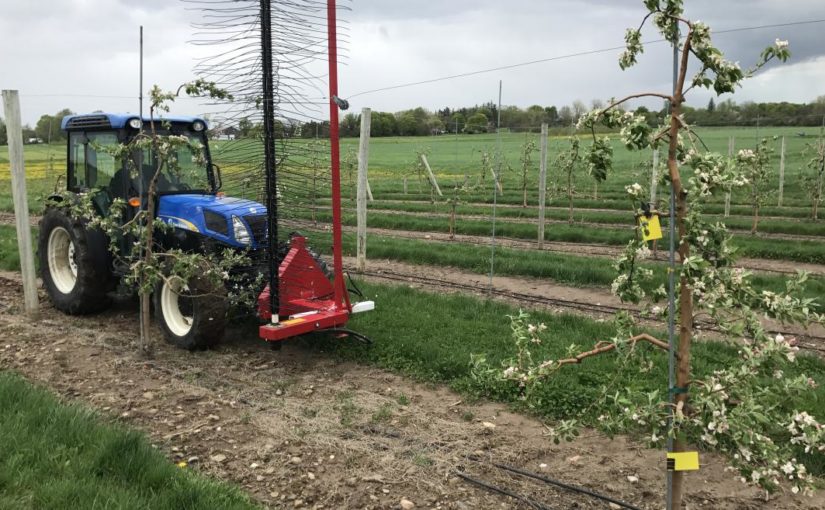Nov 4, 2020How orchards leverage mechanical thinning, pruning to curb fire blight
Pruning an apple orchard comes with many rewards for commercial apple growers including optimal crop load, ripeness and sugar levels.
Mechanical pruning and thinning is an effective alternative to long and laborious hand pruning, but commercial orchards have been slow to implement these efficiencies due to grower concern for potential development and spread of apple fire blight, a devastating disease which causes an estimated $100 million of damage in U.S. orchards annually.
New findings from the lab of Kerik Cox, associate professor of plant pathology and plant-microbe biology, indicate that there may be hope for producers vying to use these technologies.
Published by the American Phytopathological Society in September, the paper – “Assessing and minimizing the development and spread of fire blight following mechanical thinning and pruning in apple orchards,” – demonstrates that timing is critical.
“Fire blight is a really infectious disease, so picking the right time frames for mechanical thinning and pruning makes a difference,” said Cox. “Otherwise, if done when trees are susceptible to the disease, machines could potentially spread the disease across an entire orchard.”


The research, conducted from 2018 to 2019, included the evaluation of fire blight risk and spread following mechanical thinning in Gala and Idared orchards at Cornell AgriTech in Geneva, New York. The work aligned with early bloom, when season temperatures were cooler and there were few open flowers available for infection.
Additionally, the team assessed the same orchards following mechanical pruning and thinning in July and August, before and after bud set, when shoot growth is slowed, making it less susceptible to infection.
As an additional insurance for disease prevention, his lab analyzed the potential efficacy of streptomycin – an antibiotic routinely used to control fire blight –following mechanical thinning and pruning during both time periods.
“One of our most surprising findings was that in the Gala orchard, fire blight never developed beyond an inoculated tree, following thinning and pruning, which was not expected for this susceptible cultivar,” said Anna Wallis, a graduate student at Cornell AgriTech and the paper’s lead author.
In the Idared orchard, while the disease sometimes spread beyond trees inoculated with the disease following mechanical thinning and pruning, the incidence was low. And if trees were treated with streptomycin after thinning and pruning, the spread of the disease was even lower.
Wallis said the time periods chosen for the research also aligned with when growers should be pruning and thinning. Thinning during early bloom helps growers have a balanced crop load and mechanical hedging in July and August helps distribute the right amount of shade in the canopy, so fruits see more sun.
And for growers still concerned about spreading fire blight, the research shows that applying streptomycin could potentially be helpful if applied in conjunction with mechanical pruning and thinning.
“Ultimately, mechanical pruning if done at the right time, is efficient, effective and safe for New York’s important commercial apple industry,” said Wallis.
– Erin Rodger is the senior manager of marketing and communications are Cornell AgriTech.
Photo at top: Anna Wallis, graduate student, examines trees for fire blight in a Cornell AgriTech orchard. Photo: Allison Usavage















